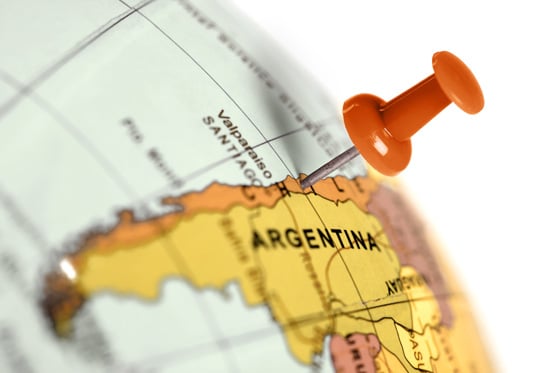The International Trade Blog Export Forms
U.S.-Chile FTA: How to Qualify and the Certificate of Origin Form
On: March 28, 2022 | By:  Sue Senger |
7 min. read
Sue Senger |
7 min. read

The U.S.-Chile Free Trade Agreement (FTA) became effective on Jan. 1, 2004. At that time, more than 85% of two-way trade in consumer and industrial goods became duty free, and as of Jan. 1, 2015, all qualifying products are now duty free.
To take advantage of the benefits for U.S. goods under this free trade agreement, exporters will need to understand how to determine that their goods are originating or qualify for preferential duty treatment under the U.S.-Chile FTA Rules of Origin. U.S. exporters whose products qualify may provide their Chilean customers considerable savings. To claim those preferential duty rates, the Chilean importer must provide written declaration that the goods qualify.
Rules of Origin
Rules of origin are written in relation to the Harmonized System of Tariff Classification, also known as the Schedule B. The first step to using the rules is to obtain the appropriate Schedule B code for the product in question.
A rule of origin may consist of:
- A change in tariff classification.
- A Regional Value Content requirement.
- Both a change in tariff classification and a Regional Value Content requirement.
It is necessary to refer to the rule associated with the product being exported. Regional Value Content can only be applied when it is allowed under a product-specific rule. The tariff schedule of the United States used to implement the U.S.-Chile Free Trade Agreement can be found at the United States International Trade Commission website.
To better understand how to apply these rules, here are some examples:
Simple Tariff Shift
Rule of Origin: "A change to heading 1902 through 1905 from any other chapter.”
Products: Breads, pastries, cakes, biscuits (HS 1905.90)
Non-U.S. or Chilean input: Flour (classified in HS chapter 11), imported from Europe.
Explanation: For all products classified in HS headings 1902 through 1905, all non-U.S. or Chilean inputs must be classified in an HS chapter other than HS chapter 19 for the product to obtain preferential duty treatment. These baked goods would qualify for tariff preference because the non-originating goods are classified outside of HS chapter 19. (The flour is in chapter 11). However, if these products were produced with non-originating mixes, then these products would not qualify because mixes are classified in HS chapter 19, the same chapter as baked goods.
Tariff Shift and Regional Value Content
Rule of Origin:
- “A change to subheading 9403.10 through 9403.80 from any other heading;” or
- “A change to subheading 9403.10 through 9403.80 from any other subheading, including another subheading within that group, provided there is a Regional Value Content of not less than:
(a) 35% when the build-up method is used, or
(b) 45% when the build-down method is used.”
Product: Wooden Furniture (HS 9403.50)
Non-U.S. or Chilean input: Parts of furniture (classified in 9403.90), imported from Asia.
Explanation: Wooden furniture can qualify for preferential tariff treatment in two different ways—through a tariff shift, or a combination of a tariff shift and Regional Value Content requirement.
Because the non-U.S. or Chilean input is classified in the same heading (9403) as the final product in this case, the good does not qualify under the simple tariff shift in the first rule. Moving down to the second rule, the good can meet the tariff shift because the non-originating component is from a different subheading than the final product. For the good to qualify as originating, however, it must also pass the Regional Value content test.
Regional Value Content
The Regional Value Content test allows the good to qualify using either one of two methods. These are the build-down and build-up methods.
Build-Down Method
Regional Value Content (RVC) = (((Adjusted value) - (Value of Non-Originating Materials)) / (Adjusted Value)) x 100
Build-Up Method
Regional Value Content (RVC) = ((Value of Originating Materials) / (Adjusted Value)) x 100
Using the example above, we will assume that the adjusted value for the piece of furniture in question is $1,000.
According to Article 4.3 of the U.S.-Chile FTA Rules of Origin, the value of non-originating materials used in the production of the good excludes:
- The cost of freight, insurance, packing and all other costs incurred in transporting the material to the location of the producer;
- Duties, taxes and customs brokerage fees on the material paid in the territory of one or both of the parties, other than duties and taxes that are waived, refunded, refundable or otherwise recoverable, including credit against duty or tax paid or payable;
- The cost of waste and spoilage resulting from the use of the material in the production of the good, less the value of renewable scrap or byproducts; and
- The cost of originating materials used in the production of the non-originating material in the territory of a party.
The assumed value of non-originating materials in this case is $500.
Plugging this into the build-down formula:
Regional Value Content (RVC) = (($1,000 – $500) / $1,000) x 100 = 50%
The percentage is greater than the 45% required by the rule; therefore, the good qualifies as originating.
Using the build-up formula:
Regional Value Content (RVC) = ($500 / $1,000) x 100 = 50%
The Regional Value Content is again 50% and is greater than the 35% required by the rule.
With either method, the good specified in this example qualifies as originating under the U.S.-Chile Free Trade Agreement.
Certificate of Origin
Once exporters understand if their goods are originating or qualify for preferential duty treatment under the rules of origin, a U.S.-Chile Certificate of Origin form can be used to claim that preferential duty rate.
A written declaration of origin can take many forms, including a statement on company letterhead, a statement on a commercial invoice or a formal certificate of origin. While no official form is required to declare origin under the U.S.-Chile FTA, the National Customs Service of Chile has issued a list of required data elements.
You'll find a free PDF version of a U.S.-Chile Certificate of Origin form at the Shipping Solutions website, and it includes all of the required data elements.
Shipments under $2,500 in value do not require a written declaration of U.S. or Chilean origin.
Declaring Goods as Originating
The Chilean importer is responsible for claiming preferential treatment for a given shipment at the time the goods are cleared through customs. (Under the U.S.-Chile FTA, the ultimate responsibility for the validity of the claim lies with the importer, not the exporter.)
Despite the fact that the ultimate responsibility for making the declaration lies with the importer, the information needed to support the declaration will have to be provided by the producer. The written declaration that the goods are originating may be produced by the exporter, importer or producer of the goods.
If someone other than the producer (i.e., the exporter or importer) issues the declaration, it must be based upon either:
- A written declaration of origin issued by the producer.
- The issuer's intimate knowledge of the product, its manufacture, and its components.
The importer is heavily dependent upon the assistance and cooperation of its U.S. suppliers in producing accurate and well-documented declarations of origin.
Special Cases
In some cases, a considerable amount of research into the inputs in the production of the goods is required to determine origin. Many exporters and importers believe that the only time that the declaration of origin can be provided is at the time the shipment clears customs, creating a sense of urgency in determining the origin of the goods.
To obtain the reduced duty rate immediately, this is true. The importer, however, has another option. The importer may pay the non-preferential duties at the time the goods clear customs, but they have up to a year from the import date to apply for a refund of excess duties. This may happen in cases where the information required to determine that the goods are originating is not available at the time of shipment.
When the importer applies for a refund of the excess duties, they are required to supply a written declaration of the goods’ originating status.
In some situations, an exporter may find that multiple shipments of identical goods are being sent to the same Chilean importer. In these cases, the exporter doesn’t need to create new written declarations of origin for each individual shipment. Instead, the importer may maintain a blanket declaration or certificate of origin to be presented to customs at the acceptance of each shipment. Chilean customs suggests that the blanket period not exceed one year.
Supporting Documentation
The company that issues the written declaration of origin is required to maintain a copy of the declaration for five years from the date of importation of the goods. In addition, that company must also save a copy of all the supporting documentation used to demonstrate that the goods qualify as originating under the U.S.-Chile FTA rules of origin.
Filing a Correction
If, after a declaration of origin has been filed with Chilean customs, one of the parties to the transaction realizes that the declaration or certificate was prepared based on incorrect information or it contains some type of error, the issuer of the declaration of origin must immediately notify, in writing, every person to whom it was originally issued.
While the importer will have to pay the customs authority unpaid duties, Chilean customs may not impose penalties on the issuer of the certificate of origin if notification of such an error was provided in a timely fashion, as defined by the U.S.-Chile FTA.
Like what you read? Subscribe today to the International Trade Blog to get the latest news and tips for exporters and importers delivered to your inbox.
This article, which was first published in May 2004, has been updated to include current information and web links.

About the Author: Sue Senger
Sue Senger is retired after a long career as an international trade consultant and faculty member at St. Paul College in St. Paul, Minnesota. She taught classes in Business Management, Supply Chain Logistics, Entrepreneurship/Marketing and Global Trade.




.webp?width=763&height=852&name=CTA%20-%20How%20to%20Qualify%20for%20a%20Free%20Trade%20Agreement%20(FTA).webp)